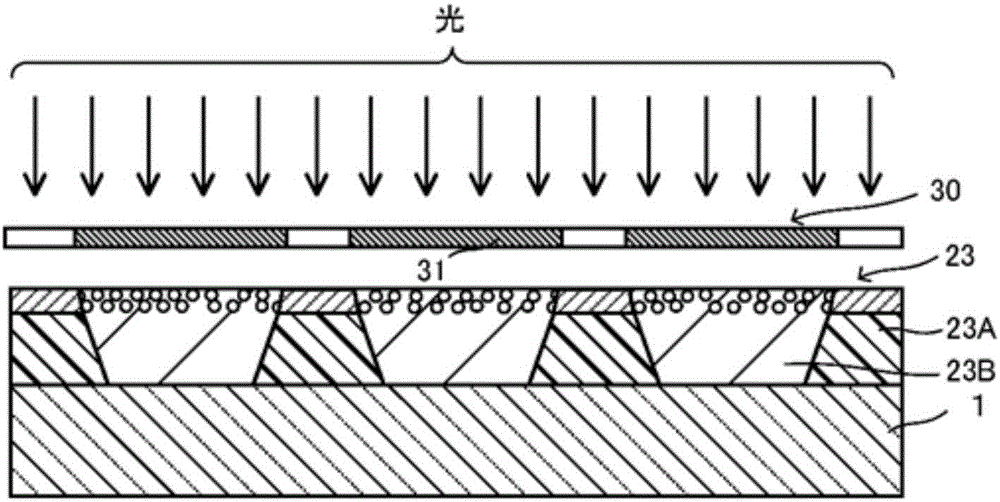Ink repellent, negative photosensitive resin composition, partitioning walls, and light emitting element
A technology of photosensitive resin and partition wall, which is applied in the field of ink repellent, can solve the problems of uniform coating of ink, lower ink affinity of openings, difficult removal of negative photosensitive resin composition, etc., and achieve good storage stability , The effect of sufficient storage stability
- Summary
- Abstract
- Description
- Claims
- Application Information
AI Technical Summary
Problems solved by technology
Method used
Image
Examples
Embodiment
[0416] Hereinafter, although this invention is demonstrated based on an Example, this invention is not limited to them. Examples 1, 2, 5-8, and Examples 10-16 are examples, and Examples 3, 4, 9, and Examples 17-19 are comparative examples.
[0417] Each measurement was performed by the following method.
[0418] [number average molecular weight (Mn), mass average molecular weight (Mw)]
[0419] The number average molecular weight (Mn) and the mass average molecular weight (Mw) were measured by gel permeation chromatography using polystyrene as a standard substance. As gel permeation chromatography, HPLC-8220GPC (manufactured by Tosoh Corporation) was used. As the column, a column obtained by connecting three Shodex LF-604 pieces was used. As a detector, an RI detector is used. As a standard substance, EasiCalPS1 (manufactured by Polymer Laboratories) was used. Furthermore, when measuring the number average molecular weight and mass average molecular weight, the column was...
example 1
[0463] (Example 1; Synthesis of Polymer (C1-1))
[0464] At 300cm equipped with a mixer 3 3.87 g of compound (cx-11), 13.30 g of compound (cx-21), 4.16 g of compound (cx-31), and 1.28 g of compound (cx-51) were added to a three-necked flask in a separate flask to obtain a hydrolyzable silane compound mixture. Next, 71.1 g of PGME was added to this mixture to prepare a raw material solution.
[0465] 6.30 g of 1% nitric acid aqueous solution was dripped at the obtained raw material solution. After the dropwise addition, it was stirred at 40° C. for 12 hours to obtain a PGME solution of the polymer (C1-1) (polymer (C1-1) concentration: 10% by mass, hereinafter also referred to as “polymer (C1-1) solution".).
[0466] It should be noted that after the completion of the reaction, the components of the reaction solution were measured using gas chromatography, and it was confirmed that each compound used as a raw material was below the detection limit.
[0467] Table 1 shows the...
example 2~4
[0468] (Examples 2-4: Synthesis of polymers (C1-2) and (Cf-1), (Cf-2))
[0469] Except that the raw material composition was set as shown in Table 1, the same procedure as Example 1 was performed, that is, PGME was added to the mixture of each silane compound shown in Table 1 to prepare a raw material solution, and the acid shown in Table 1 was added dropwise thereto. aqueous solution and stirred in the same manner as Example 1 to obtain solutions of polymer (C1-2) and (Cf-1), (Cf-2) (both compound concentration: 10% by mass, each solution is also referred to as "polymerization" hereinafter). Substance (C1-2), (Cf-1), (Cf-2) solution".).
[0470] Table 1 shows the feed amounts and molar ratios of the raw material hydrolyzable silane compounds used in the production of the polymers (C1-2) obtained above and (Cf-1) and (Cf-2). In Table 1, the silane compound means a hydrolyzable silane compound. In addition, the measurement results of the number average molecular weight (Mn), ...
PUM
| Property | Measurement | Unit |
|---|---|---|
| acid value | aaaaa | aaaaa |
| particle diameter | aaaaa | aaaaa |
| amine value | aaaaa | aaaaa |
Abstract
Description
Claims
Application Information
 Login to View More
Login to View More - R&D
- Intellectual Property
- Life Sciences
- Materials
- Tech Scout
- Unparalleled Data Quality
- Higher Quality Content
- 60% Fewer Hallucinations
Browse by: Latest US Patents, China's latest patents, Technical Efficacy Thesaurus, Application Domain, Technology Topic, Popular Technical Reports.
© 2025 PatSnap. All rights reserved.Legal|Privacy policy|Modern Slavery Act Transparency Statement|Sitemap|About US| Contact US: help@patsnap.com



